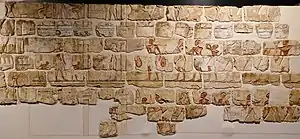Talatat
Talatat are limestone blocks[1] of standardized size (c. 27 by 27 by 54 cm, corresponding to 1⁄2 by 1⁄2 by 1 ancient Egyptian cubits) used during the 18th Dynasty reign of the Pharaoh Akhenaten in the building of the Aton temples at Karnak and Akhetaten (modern Amarna). The standardized size and their small weight made construction more efficient.[2] Their use may have begun in the second year of Akhenaten's reign.[3] After the Amarna Period talatat construction was abandoned, apparently not having withstood the test of time.[4]
.jpg.webp)

The minority of blocks intended for a visible surface are often decorated in a variety of techniques to make up large scenes covering several blocks. Sunk relief, engraving paint, and sometimes added plaster are used, often in combination.
Amenhotep IV talatats
_MET_DP120058.jpg.webp)
The blocks used in the Temple of Amenhotep IV in Karnak, and the other abandoned temples devoted to the deity Aten, were reused by Horemheb and Ramesses II as filler material for pylons and as foundations for large buildings. The Great Hypostyle Hall at Karnak is built on thousands of these blocks, as is the Second Pylon.[5]
Tens of thousands of the talatat have been recovered. The decorated stones are being photographed and the scenes they depict are reconstructed as part of the Akhenaten Temple Project.[6]
Etymology
The term talatat was apparently used by the Egyptian workmen and introduced into the language of archaeology by the Egyptologist H. Chevrier. There are two hypotheses as to the word's generally unknown ultimate origin in reference to the stones, perhaps not contradictory: [7] The word may be derived from Italian tagliata, meaning cut masonry. [8] Or, derived from the Egyptian Arabic word تلاتة (talāta, 'three'), indicating that each block is three hand-spans long. [9]
References
- Harrell (2001), p. 36–8
- Arnold (2002), p. 238
- Bard (1999), p. 392
- Shaw (2003), p. 274
- Bard (1999), p. 391
- Bard (1999), pp. 391f
- Grimal (1992), p. 227
- Bard (1999), p. 391
- Kemp, Barry (2012). The City of Akhenaten and Nefertiti: Amarna and its People (2014 paperback ed.). New York: Thames & Hudson. p. 60. ISBN 978-0-500-29120-7.
Bibliography
- Harrell, J.A (2001). Ancient quarries near Amarna. Egyptian Archaeology 19, 36–8.
- Arnold, Dieter (2002). The Encyclopaedia of Ancient Egyptian Architecture. I. B. Tauris.
- Bard, Katheryn A. (1999). Encyclopedia of the Archaeology of Ancient Egypt. Routledge.
- Grimal, Nicholas (1992). A History of Ancient Egypt. Blackwell Publishing.
- Shaw, Ian (2003). The Oxford History of Ancient Egypt. Oxford University Press.
External links
- Talatat wall Scene www.usu.edu
- Akhenaten worshipping scene: Talatat Article euler.sle.edu